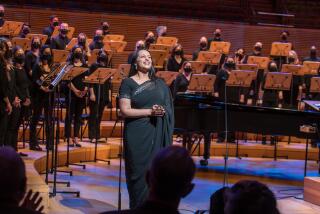Experimental Instruments : Musician Hears Melodies Where Others Hear Noise
- Share via
POINT REYES STATION, Calif. — Bart Hopkin is a renegade musician who likes to play to a different tune.
Hopkin builds, seeks out and plays experimental instruments made with strings, membranes, air, water, wood and other vibrating devices and materials.
The offbeat instruments have such names as rebar scraper chimes, chromatic rumba box, tunable pan pipes and a device called wheels of time that is made with circular saw blades mounted on a wooden resonator and struck with beaters.
Hopkin said there is even a 23-foot-tall wind harp on a bluff overlooking the sea near Washington’s Puget Sound. The wind harp sings in the breeze with shifting overtone patterns and subsonic tones in a huge soundboard.
Plays Classical Guitar
“With the wind harp, you couldn’t hum the tune it plays,” said the bearded musician who strums classical guitar at a local restaurant to help pay his bills. “But with many of the alternative instruments, you could still perform popular songs.”
The history of music, he said, is marked by periodic movements away from the constraints of conventional practice, and only a few musicians have broken the restrictions imposed by 20 or 30 standard instruments.
“We have only rarely thought, in the past, to look into the realm of possible sounds that lies beyond and between these instruments,” said Hopkin, who has just published the first edition of a newsletter called Experimental Musical Instruments.
Hopkin said musicians’ attitudes are changing and more are getting involved in creative instrument design and construction, working with diverse and imaginative acoustic devices and “sound sculpture.”
‘New Creativity Is Fun’
“The search for new sound sources has become one of the most fertile areas of musical development,” said Hopkin, a Berkeley resident who specialized in folklore and ethnomusicology at Harvard University. “And this new creativity is fun. It is challenging and terribly interesting. It’s great to see and hear and be part of.”
The newsletter, he said, serves as a forum for people interested in the design, construction and enjoyment of new musical sound sources.
“In it one can find articles on specific new instruments and their builders, practical discussions of tools, techniques and acoustics, guides to events and to bibliographic and discographic resources and letters.”
Hopkin said he will leave the philosophical debates over whether to change conventional musical scales and tuning systems to the composers and scholars.
“I avoid trying to define what music is,” he said.
More to Read
The biggest entertainment stories
Get our big stories about Hollywood, film, television, music, arts, culture and more right in your inbox as soon as they publish.
You may occasionally receive promotional content from the Los Angeles Times.










